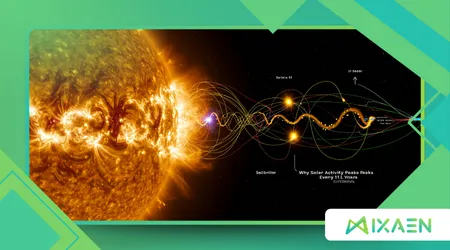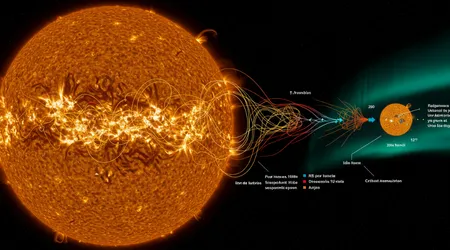Why Solar Activity Peaks Every 11 Years

The Sun, our life-giving star, is anything but static. It pulses, flares, and undergoes dramatic transformations on a regular schedule, leading to intense periods of space weather.
Anúncios
The fundamental question for scientists and the public alike remains: Why Solar Activity Peaks Every 11 Years? This rhythmic surge and decline known as the solar cycle is a monumental dance driven by the Sun’s magnetic field, not its core nuclear fusion.
Understanding this cycle is critical in 2025, particularly as our planet becomes increasingly reliant on vulnerable satellite technology and power grids. This comprehensive exploration delves into the complex physics that govern this celestial periodicity.
We will dissect the mechanism of magnetic field reversal, differentiate between the 11-year sunspot cycle and the 22-year magnetic cycle, and examine the real-world implications of these massive energetic events. Prepare to look beyond simple sunspots and grasp the true magnetic heart of our star’s influence.
The Engine of the Cycle: Differential Rotation and the Dynamo
The driving force behind the 11-year cycle is not thermal but magnetic. It lies in the fluid, conductive plasma that makes up the Sun’s interior and its unique rotational pattern.
Anúncios
The Sun’s Uneven Spin (Differential Rotation)
Unlike a solid body, the Sun rotates at different speeds depending on the latitude. The equator spins once every 25 days, significantly faster than the poles, which take approximately 35 days. This phenomenon is known as differential rotation.
This uneven rotation constantly drags and stretches the magnetic field lines. Imagine the field lines as rubber bands initially running north-south. The equator’s speed stretches them horizontally, wrapping them tightly around the Sun’s circumference like thread on a spool.
This immense torsional stress concentrates the magnetic energy. The stretching amplifies the field’s strength, leading to localized buoyancy effects. This mechanical stress is the physical origin of the solar cycle, helping explain Why Solar Activity Peaks Every 11 Years.
++ Solar Cycle 25 sunspot progression
The Solar Dynamo and the Magnetic Field Reversal
The continuous stretching and twisting of these magnetic field lines cause them to buckle and push through the surface, creating sunspots. These sunspots are cooler, magnetically intense regions that appear in pairs (north and south poles).
As the cycle progresses, more magnetic field lines break through, increasing the sunspot number until the field is maximally twisted the Solar Maximum.
At this peak, the global magnetic field becomes so complex and entangled that it fundamentally collapses and reverses polarity.
The old North Pole becomes the new South Pole and vice versa. This complete reversal process defines the 22-year Hale Cycle.
The familiar 11-year cycle simply represents the time it takes to go from one polarity minimum, through the maximum, to the next polarity minimum.

The Peak Phenomena: Sunspots, Flares, and Ejections
The period surrounding the solar maximum is characterized by a dramatic increase in visible and energetic phenomena, which are the direct physical manifestations of the twisted magnetic fields.
Also read: Double X-Class Flares: Recent Events, Effects, and How Scientists Monitor Them
Sunspot Numbers as the Key Metric
The most visible sign of the cycle’s intensity is the sunspot number a historical index dating back to the 17th century. The number of sunspots directly correlates with the amount of magnetic energy near the surface.
A period of Solar Minimum can see days or weeks pass without a single visible sunspot. Conversely, during Solar Maximum, dozens of complex, massive sunspot groups can pepper the Sun’s face simultaneously. This metric provides a simple yet accurate measure of Why Solar Activity Peaks Every 11 Years.
This peak in magnetic complexity acts as the source for the most energetic events. The tangled field lines become highly unstable, like over-stretched springs ready to snap.
Read more: How Solar Winds Influence Space Weather on Earth
Solar Flares and Coronal Mass Ejections (CMEs)
When the highly stressed magnetic field lines near a sunspot group suddenly snap and realign, they release immense energy in the form of Solar Flares (bursts of X-rays and radiation). These flares travel at the speed of light, reaching Earth in just eight minutes.
Even more powerful are Coronal Mass Ejections (CMEs), which are colossal eruptions of magnetized plasma hurled into space.
CMEs are slower than flares (taking days to reach Earth) but carry vastly more mass and pose the greatest threat to our technological infrastructure.
The magnetic complexity at the solar maximum dramatically increases the frequency of these Earth-directed threats.
Example: The current cycle, Solar Cycle 25, began in 2019 and is projected by NOAA’s Space Weather Prediction Center (SWPC) to reach its maximum sometime in 2024 or early 2025.
This prediction highlights the current real-time relevance of understanding Why Solar Activity Peaks Every 11 Years.
Terrestrial Consequences: Earth’s Vulnerability
The Sun’s cyclic activity isn’t just an academic curiosity; it has profound, practical impacts on Earth’s infrastructure and technology, making the monitoring of the solar maximum a top global priority in 2025.
Geostorms and Grid Impact
When a powerful CME collides with Earth’s magnetosphere, it generates a geomagnetic storm. This rapid change in the Earth’s magnetic field induces geomagnetically induced currents (GICs) in long conductive paths, such as power transmission lines and pipelines.
GICs can overwhelm and permanently damage high-voltage transformers, leading to widespread power grid failures.
The largest known event, the 1859 Carrington Event, caused widespread telegraph system failures. A similar event today could result in trillion-dollar damages and extended blackouts, demonstrating the urgency of anticipating the solar maximum.
Satellite and Communication Disruption
Satellites, particularly those used for GPS navigation and global communication, are highly susceptible to solar activity. Increased solar radiation and atmospheric heating during a solar maximum cause the Earth’s upper atmosphere to expand.
This atmospheric drag pulls down low-Earth orbit (LEO) satellites, shortening their lifespan and requiring continuous, expensive orbital corrections.
Furthermore, the radiation from flares can scramble satellite electronics and disrupt high-frequency radio communications used by aviation and emergency services. This continuous operational threat explains a key reason Why Solar Activity Peaks Every 11 Years is crucial for modern industries.
Analogy: The Sun’s magnetic field is like a giant rubber band ball. As the ball spins differentially, the bands twist tighter and tighter (Solar Maximum), causing sudden snaps (Solar Flares/CMEs) that temporarily destabilize the entire system (Earth’s magnetic field).
Predicting the Future: Challenges and Modern Monitoring
Predicting the exact intensity and timing of the solar cycle remains one of the greatest challenges in astrophysics.
The Role of Meridional Flow
Modern research focuses on the meridional flow the slow circulation of plasma from the equator toward the poles.
This flow is believed to be the “conveyor belt” that transports the old magnetic field to the poles, where it submerges and eventually re-emerges with the opposite polarity, driving the next cycle. The speed of this flow may be key to forecasting the cycle’s strength.
Research Data: Data from the SOHO and SDO missions, analyzed in a 2023 study published in The Astrophysical Journal, showed that variations in the subsurface meridional flow rate correlated strongly with the relative weakness or strength of subsequent solar cycles.
Faster flow seemed to generate a weaker subsequent cycle, adding complexity to the standard 11-year model.
This ongoing research aims to refine predictions beyond the current 65% accuracy range. A stronger predictive model allows power companies and satellite operators more time to implement protective measures, lessening global risk.
| Solar Cycle Phase | Key Sunspot Characteristic | Magnetic Field Polarity at North Pole | Risk of Major CME Events |
| Minimum | Few to zero sunspots; quiet Sun surface. | Stable (e.g., North) | Low |
| Rising Phase | Sunspots emerge at mid-latitudes; increasingly complex. | Stable | Medium-Low |
| Maximum | Peak sunspot number; large, complex groups near the equator. | Begins to reverse (Unstable) | High |
| Declining Phase | Sunspots migrate toward the equator; decreasing number. | Reversed (e.g., South) | Medium |
Conclusion: Mastering the Magnetic Rhythm
The reason Why Solar Activity Peaks Every 11 Years is a mesmerizing confluence of rotation, plasma dynamics, and magnetic instability.
It is the Sun’s intrinsic clockwork, dictating not just celestial events, but also the operational stability of our modern, interconnected world. The cycle’s predictability, though imperfect, provides humanity with the crucial opportunity to prepare for the inevitable high-energy outbursts.
As we currently head toward the peak of Solar Cycle 25, understanding this rhythm is no longer confined to physicists it is a societal necessity.
Knowing the magnetic heart of our star allows us to build a more resilient infrastructure. Which aspect of the solar cycle do you find most fascinating: the underlying physics or the impact on Earth? Share your thoughts and questions about the Sun’s next magnetic flip in the comments below!
Frequently Asked Questions (FAQ)
Q: Is the 11-year cycle exactly 11 years long?
A: No, the 11-year figure is an average. Individual cycles can vary significantly, ranging from about 9 to 14 years. Scientists measure the cycle from one solar minimum to the next, which is why accurately predicting the peak of the current cycle is always a matter of ongoing assessment and debate.
Q: Does the solar cycle affect Earth’s climate or temperature?
A: The total energy output of the Sun changes by less than 0.1% between the minimum and maximum. While this variation does have a small, measurable effect on the Earth’s atmosphere, it is far too small to be the primary driver of current global warming trends, which are overwhelmingly attributed to anthropogenic (human-caused) factors.
Q: How do scientists know when the magnetic field has reversed?
A: Scientists monitor the magnetic polarity of sunspots and, more importantly, the magnetic field measurements at the Sun’s poles. The polarity begins to weaken and then switches, a process that is completed around the time of the Solar Maximum.
This complete flip of the global dipole field is the defining feature of the 22-year Hale Cycle, clarifying Why Solar Activity Peaks Every 11 Years is only half the story.
